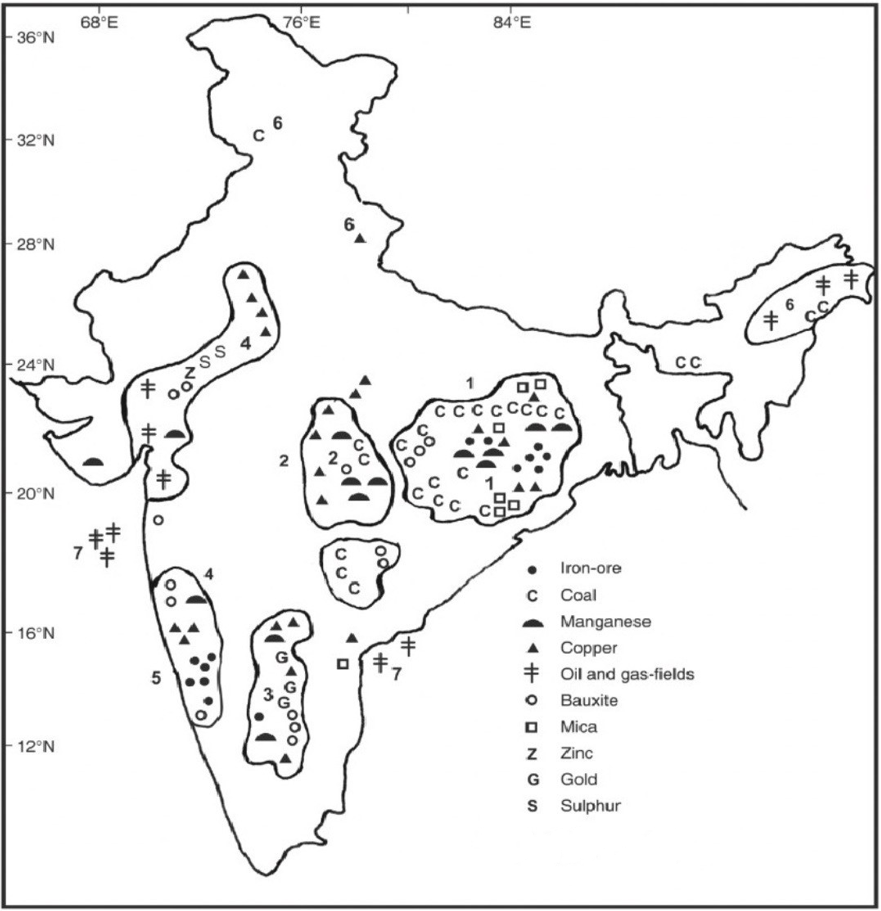-
Q. Despite being rich in mineral resources, several regions in India continue to face underdevelopment. Discuss the paradox between mineral wealth and regional development in India.
14 Apr, 2025 GS Paper 1 GeographyApproach
- Introduce the definition of the paradox of plenty and its relevance to India's mineral-rich states.
- Analyze the paradox by highlighting factors contributing to underdevelopment despite resource wealth.
- Conclude with suggestions to bridge the gap.
Introduction
The paradox of plenty describes how resource-rich regions often face poor economic growth and low human development. India's mineral belt spreads across central and eastern states, contributing over 60% of coal and iron ore output. Despite having abundant minerals like coal and iron ore, they continue to struggle with poverty, and poor public services. This gap between resource wealth and development highlights systemic governance and structural issues.
Body
The Paradox: Causes of Underdevelopment:
- Environmental and Livelihood Disruption: Large-scale mining causes deforestation, water contamination, and land degradation.
- In Odisha’s Keonjhar, iron ore mining has displaced thousands of tribals since 2000, disrupting forest-based livelihoods.
- Acidic runoff from coal mines in Meghalaya’s Jaintia Hills has rendered rivers like Kopili unfit for use, affecting agriculture and health.
- Weak Governance: Over ₹1 lakh crore collected under District Mineral Foundation (DMF) over the past decade (2015–2025) from mining leaseholders. However, more than 50% of the funds remain unspent, indicating administrative bottlenecks and weak planning.
- In Jharkhand, out of 1,164 sanctioned projects, only ₹1.86 crore was allocated for skill development and livelihood generation.
- Conflict and Extremism: Left-Wing Extremism (LWE) thrives in mineral belts due to land alienation and inequitable development.
- In Chhattisgarh’s Dantewada, over 50% of land acquired for mining since 2010 displaced tribals without adequate compensation, fueling unrest and such conflicts deter investment and infrastructure growth.
- Poor Infrastructure: Mineral-rich districts lack basic infrastructure such as roads, schools, and hospitals. SDG India Index (2023) ranks Jharkhand and Chhattisgarh among the lowest in health and education, despite high mineral exports.
- Less than 20% of Chhattisgarh’s rural areas have paved roads raising infrastructural gap issues.
- Over-reliance on mining hampers industrial diversification. Odisha’s Keonjhar district, rich in iron ore, lacks robust manufacturing or service sectors, trapping it in a resource-dependent economy.
Efforts to Bridge the Development Gap in Mineral-Rich Regions and their limitations:
Initiative Objective & Limitations District Mineral Foundation (DMF) Aims to utilize mining royalties for local development in affected districts; however, over 50% of funds remain unspent or misallocated due to poor planning. Pradhan Mantri Khanij Kshetra Kalyan Yojana (PMKKKY) Seeks to channel DMF funds into welfare schemes like health, education, and skill development; but suffers from weak monitoring. Panchayats (Extension to Scheduled Areas) (PESA) Act, 1996 Empowers Gram Sabhas in tribal areas to decide on natural resource use; yet, ineffective enforcement by states. Forest Rights Act, (FRA) 2006 Recognizes tribal rights over forest land and resources; but poor awareness, high rejection rates of claims, and bypassing of consent processes undermine its effectiveness. Aspirational Districts Programme (ADP) Targets backward, often mining-affected districts for fast-track development; yet overly focused on infrastructure over human development. Conclusion
To break the paradox of resource-rich underdevelopment, a multi-pronged approach is essential. Decentralized planning of DMF funds, with active tribal participation, can ensure that resources address local needs effectively. Strengthening environmental and social impact assessments will promote more sustainable and accountable mining practices. Targeted skilling programs aligned with local industry demands can bridge employment gaps, while investments in optical fibre connectivity and mobile health and education units can improve access to essential services in remote mining-affected areas. Together, these measures can turn the paradoxical mineral wealth into inclusive and sustainable development.
To get PDF version, Please click on "Print PDF" button.
Print PDF





